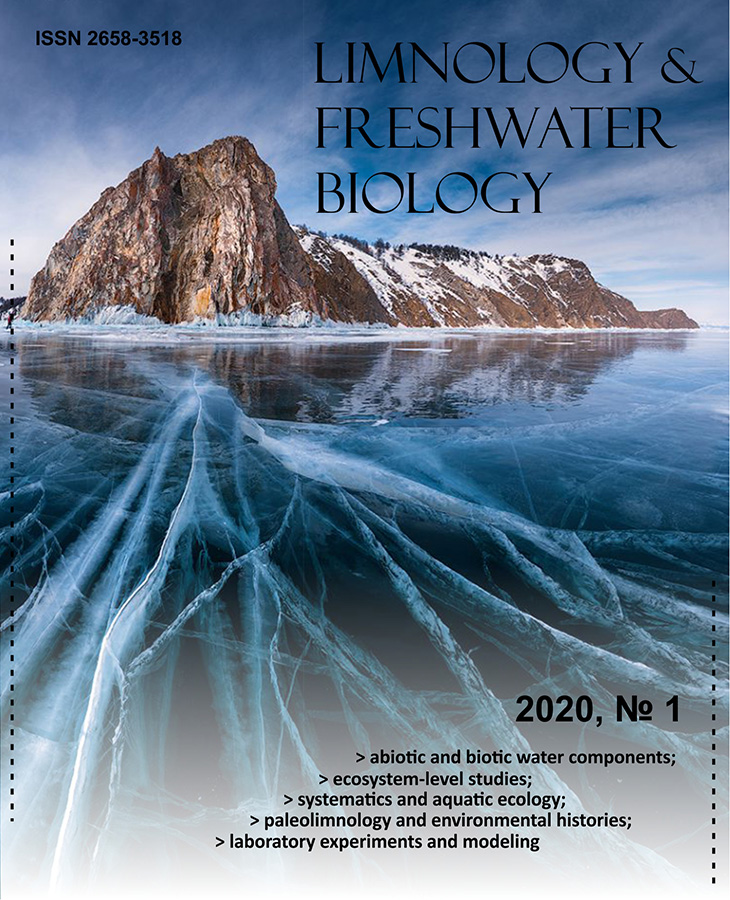No 1 (2020)
Articles
Polychlorinated biphenyls in the tributaries of Southern Baikal
Abstract
In the aquatic ecosystem of Lake Baikal, global atmospheric transport is regarded as the dominant source of polychlorinated biphenyls (PCBs). Relatively high level of PCB concentration in the southern basin of the lake is associated with PCB influx from local sources. The waters of the tributaries of Southern Baikal, which have watershed basins on the slopes of the Khamar-Daban ridge, possess significant potential as a source of pollutants. The article presents the results of PCBs monitoring in the waters of the rivers Utulik, Solzan, Khara-Murin, Snezhnaya, and Pereemnaya in 2017 and 2019. PCB concentrations in the waters of the tributaries were estimated by the total concentration of seven indicator congeners Nos. 28, 52, 101, 118, 138, 153, and 180 (ƩPCB7) in water samples taken at the estuaries of the rivers. The ƩPCB7 level in the waters - from 0.02 to 1.5 ng/L, can be comparable to or exceed that in the littoral zone of the lake. An assessment of the removal of PCBs to the southern part of Lake Baikal indicates a minimal influx of pollutants of this class with tributary waters. In 2017, the number of PCB indicator congeners that entered Lake Baikal with water runoff was estimated to be between 1.7 and 3.1 g in May and between 7.7 and 26 g in September. In extreme conditions, the water runoff of PCBs can reach 40-170 g per month, like in September 2019.
 353-357
353-357


Phylogeny of the freshwater lineages within the phyla Actinobacteria (Overview)
Abstract
This review presents molecular classification of freshwater Actinobacteria based on the phylogeny of the 16S rRNA gene. We show the classification of the entire phylum Actinobacteria and the taxonomic rank of freshwater lineages of Actinobacteria within this phylum. The discovery history of different groups of freshwater Actinobacteria is considered. We have systematized the information about the phylogeny of cultivated and uncultivated freshwater Actinobacteria and give their brief description. Data is provided on freshwater groups of Actinobacteria found in different ecotopes of Lake Baikal.
 358-363
358-363


Baikal endemic sponges in the system of ecological monitoring
Abstract
Within the framework of the monitoring of the Baikal endemic sponge fauna, which was started in 2015, we organized field observations. This study is aimed to investigate the dynamics of the disease incidence in sponges and the rate of their degradation/regeneration in the natural environment within a limited space. The observations of the tagged sponges having different shapes were carried out using the photo and video method. Thus, from 2016 to 2018, there was a deterioration dynamics in the state of most control sponges. From 2018 to 2019, the state of some sponges improved owing to the regeneration of the affected areas of the body. In this study, we revealed that Baikal sponges with encrusted and globulous shapes could recover very quickly owing to the regeneration of the affected areas and the rapid growth of the body. After almost complete degradation of the body in the encrusted sponge, the fragments remain, which can subsequently grow as individual specimens. Similar observations are currently being conducted throughout Lake Baikal.
 364-367
364-367


The Gydratny Fault zone of Lake Baikal
Abstract
The Central basin of Lake Baikal is intersected by the North-East – South-West-oriented escarpment named the «Gydratny Fault zone». This laterally extensive structure runs subparallel to the North-Western shore of the lake. The Gydratny Fault zone has been investigated using geophysical techniques during 6 years of research in the framework of international expeditions of the Class@Baikal project. The acquired seismic data provided details of the structure of the upper part of the sedimentary section revealing a system of previously unknown faults. A new tectonic scheme of the South-Western deep-water part of the Central basin is presented. The Gydratny fault is accompanied by a system of numerous synthetic and antithetic normal faults that form a wide and extended faulted zone. These structures are unevenly distributed, and include modern and active faults as well as features buried under undeformed sedimentary units with different thickness. This parameter is used to constrain the patterns observed in several zones of the study area. The difference in the characteristics of faults and their manifestations on seismic data can be explained by complex and uneven distribution of active tectonic and sedimentary processes.
 368-373
368-373


Estimation of the influx of pollutants to the territory of the South Pribaykalye
Abstract
We present the results of long-term (2010-2017) studies of chemical composition of snow cover from the area of the Baikal Region. There is significant pollution of snow cover in the industrial cities of Pribaykalye (Irkutsk and Shelekhov). Some areas are the most subjected to the atmospheric pollution. The emissions from Shelekhov enterprises influence the chemical composition of snow cover in Irkutsk. Transport, fuel and energy complex mainly influence the formation of the chemical composition in snow cover from Irkutsk. In Shelekhov, the source of contaminants is the aluminium smelter (RUSAL-IrkAZ) and power engineering. Based on the data on snow surveys, we estimated the influx of pollutants from the atmosphere to the underlying surface of industrial cities and the water area of South Baikal.
 374-381
374-381











